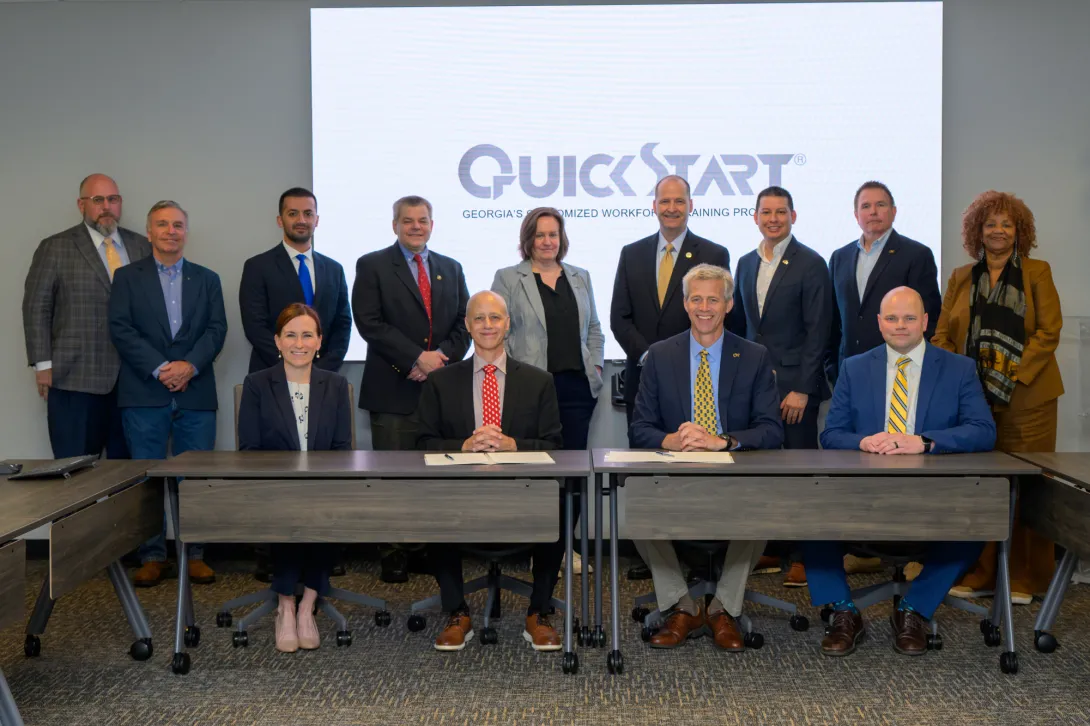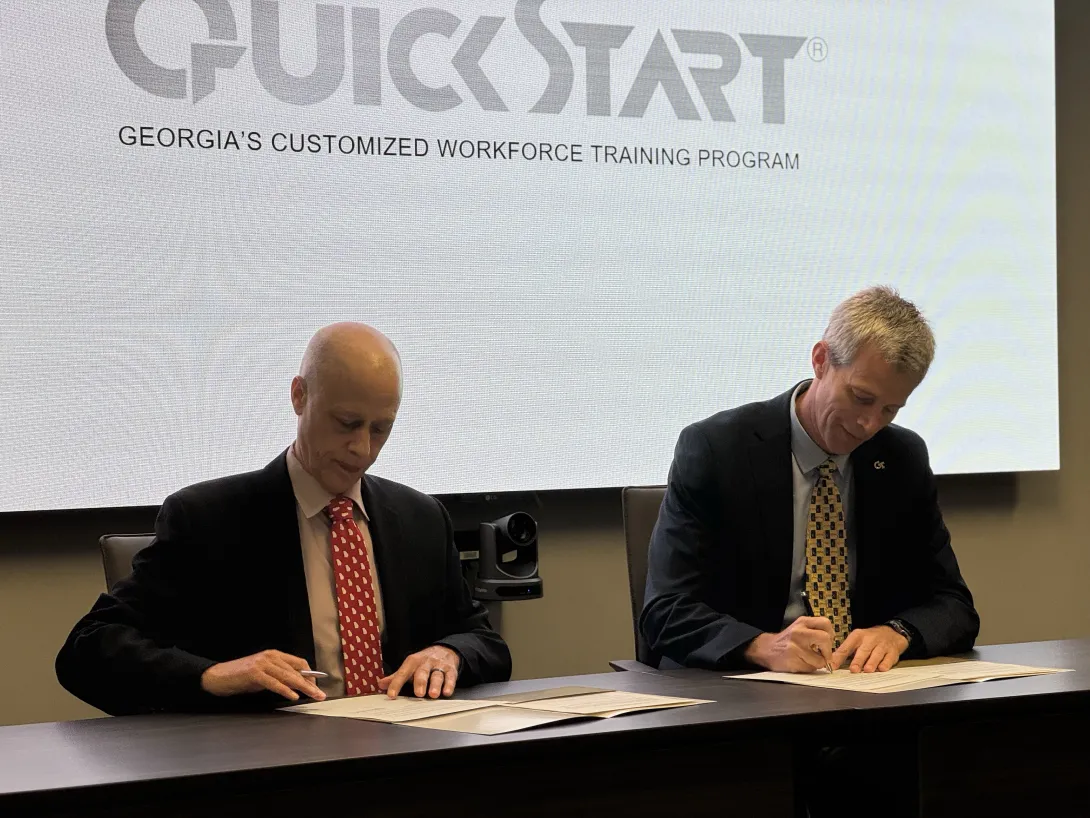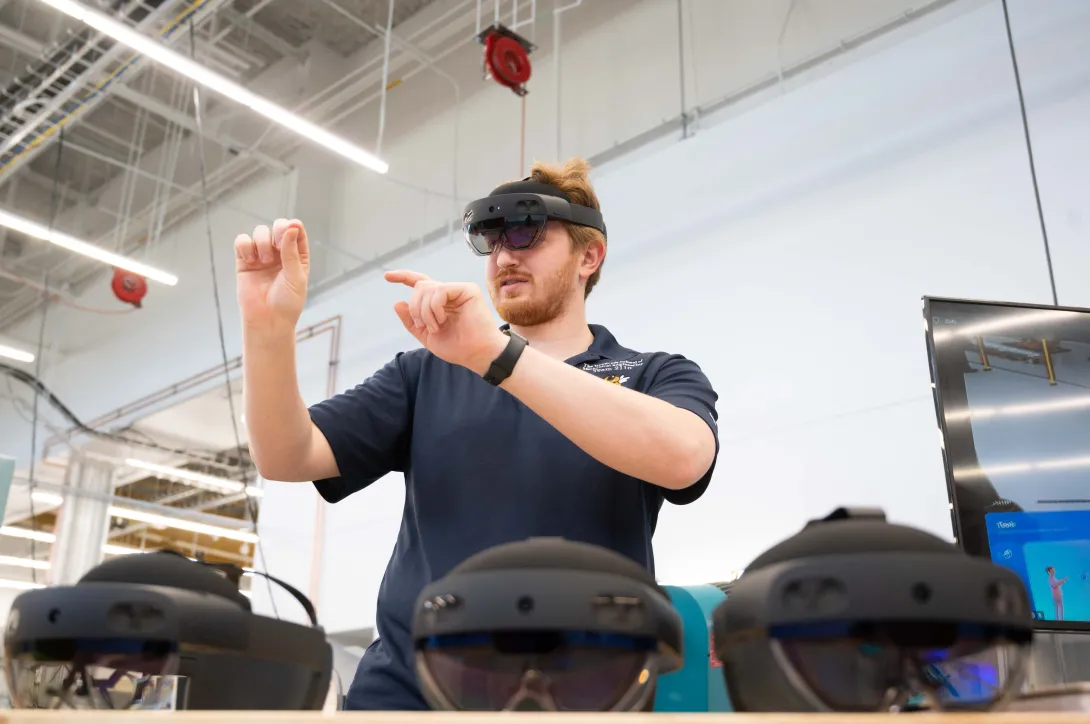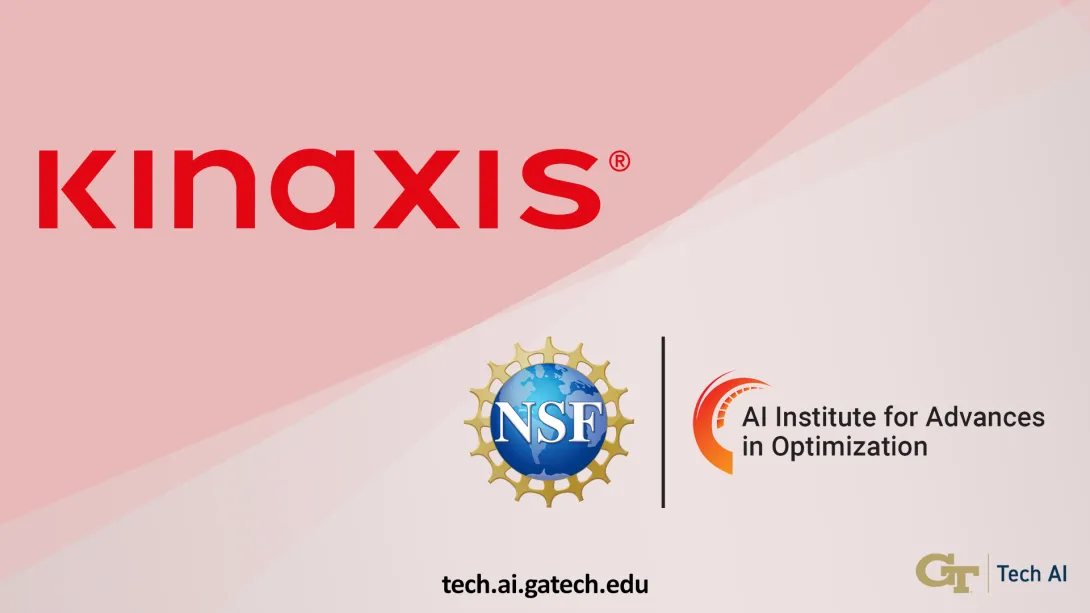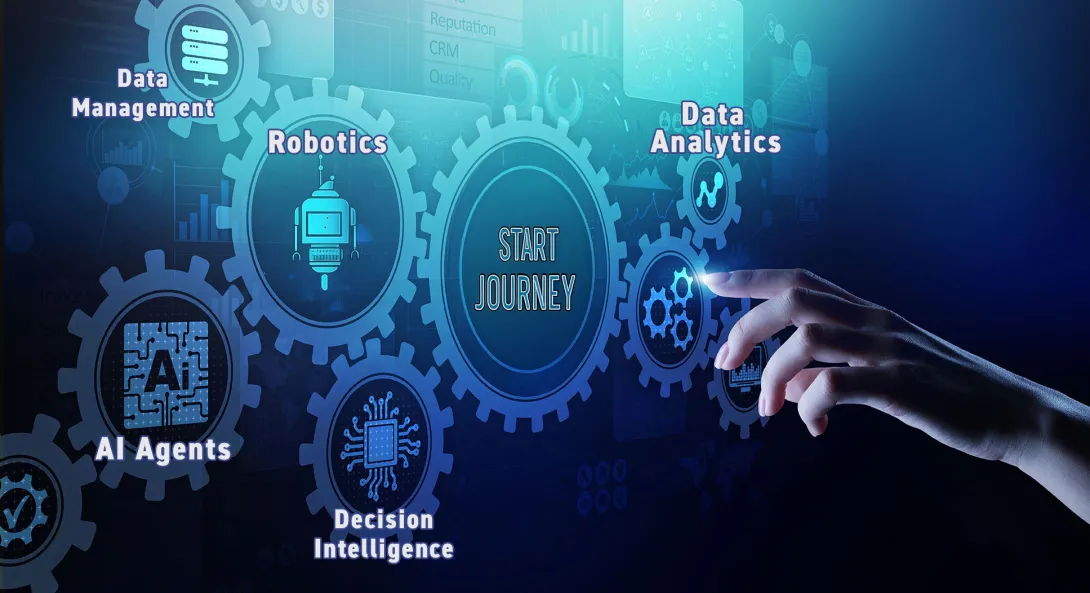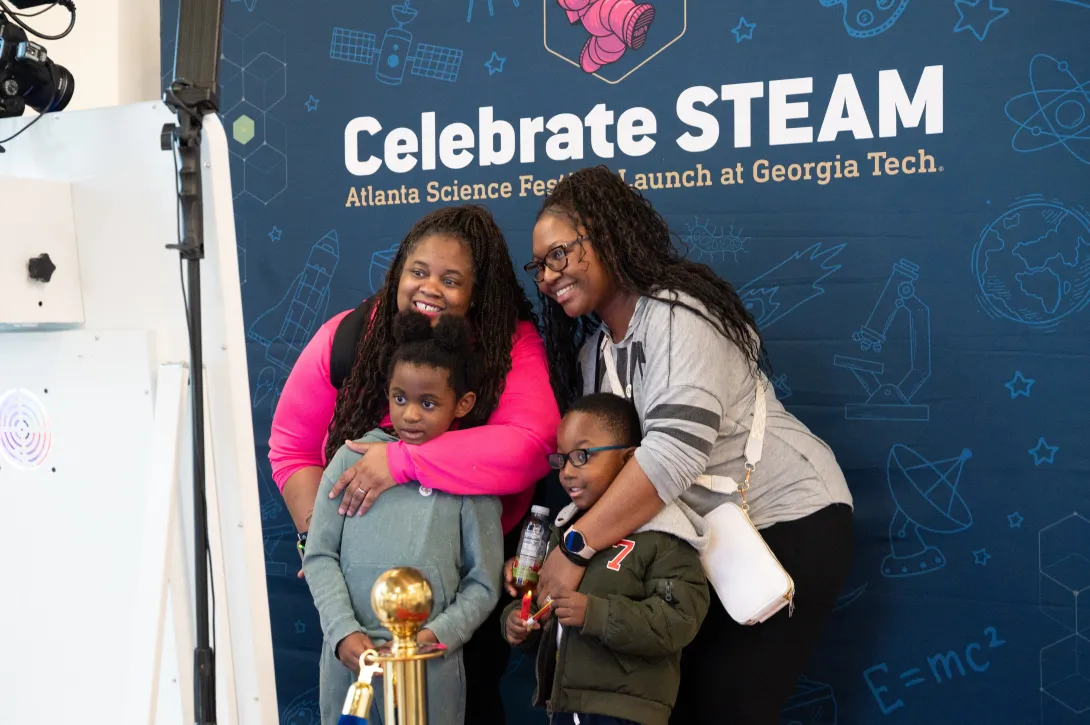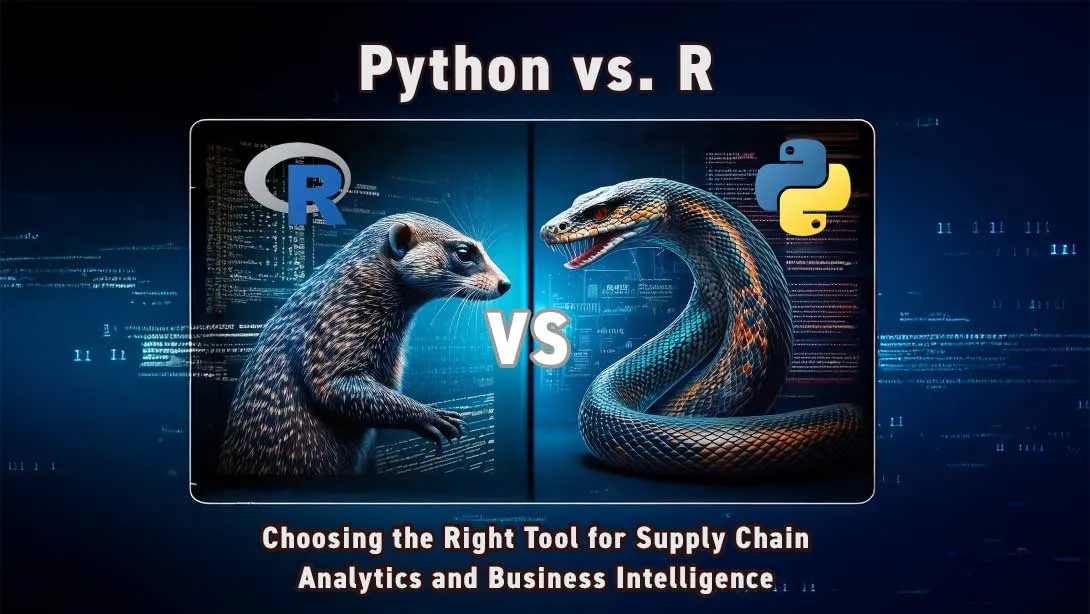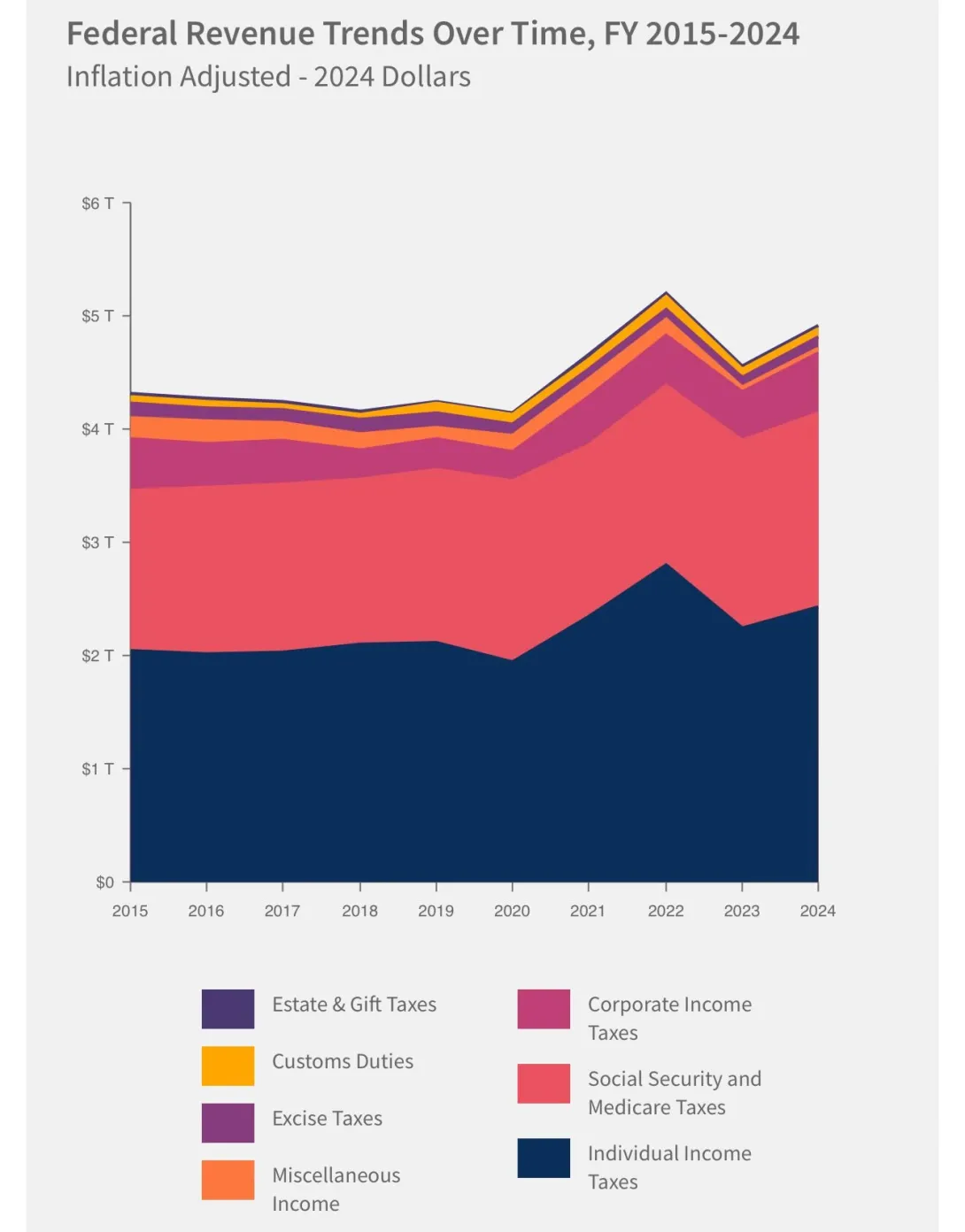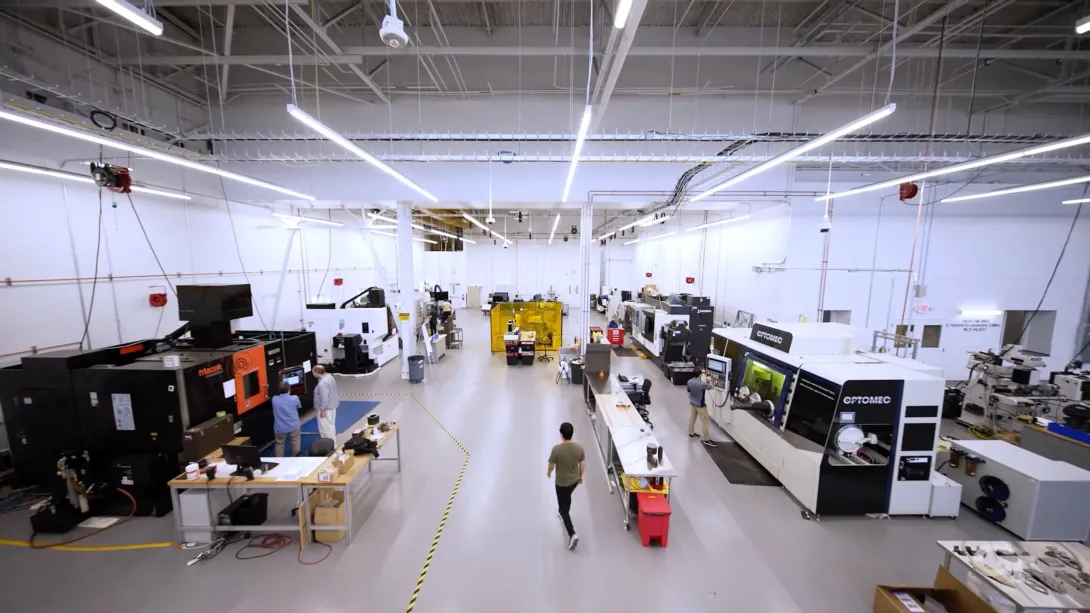Apr. 10, 2025
In a significant move to bolster Georgia's workforce, Georgia Tech has partnered with Georgia Quick Start to advance manufacturing training and skill development. This collaboration, formalized by the signing of a Memorandum of Understanding on April 8, aims to elevate the quality and efficiency of manufacturing workforce training across the state.
“At Georgia Tech, innovation isn’t just about discovery — it’s about solving real-world challenges,” said Executive Vice President for Research Tim Lieuwen. “Georgia Quick Start ensures that cutting-edge research in advanced manufacturing translates into practical training solutions. Together, we are equipping Georgia’s workforce with the skills needed to drive economic growth and industry advancement.”
As manufacturing technologies and artificial intelligence continue to evolve, U.S. manufacturers increasingly require skilled workers experienced in advanced manufacturing. For decades, Georgia Quick Start, administered by the Technical College System of Georgia, has been addressing this need and has been recognized as the country’s top workforce training program for 15 years.
Now, researchers at Georgia Tech will collaborate with Georgia Quick Start to enhance these efforts by developing Extended Reality (XR) training programs, providing a scalable and experiential solution to meet the growing demand for training.
“We have been so successful for so many years because we stay focused on relevance, flexibility, and responsiveness,” said Scott McMurray, deputy commissioner for Georgia Quick Start. “This partnership is an example of how Quick Start is able to develop and deliver effective training even for companies working on the leading edge of advanced manufacturing technologies.”
Extended Reality, Scaled Training
XR technologies use a combination of virtual and augmented reality to create immersive, interactive experiences. By simulating real-world manufacturing environments and processes, XR has the potential to allow trainees to practice and refine their skills in a controlled, risk-free setting through standardized training experiences. This not only enhances the learning experience but also ensures consistency in training quality across a large workforce.
“Virtual reality scales training by gamifying complex tasks and removing the need for costly or hazardous physical equipment. Augmented reality scales on-the-job training by providing adaptive, context-aware guidance exactly when and where it’s needed, reducing the need for expert supervision,” said manufacturing XR researcher Mohsen Moghaddam, Gary C. Butler Family associate professor in the H. Milton Stewart School of Industrial and Systems Engineering and the George W. Woodruff School of Mechanical Engineering. “Together, they make training more consistent, up-to-date, accessible, and safe, especially for workers who may hesitate to ask for assistance from peers or supervisors out of fear of judgment.”
The collaboration will leverage Moghaddam’s research and the AR/VR training space within the expanded Advanced Manufacturing Pilot Facility, providing a state-of-the-art environment for developing and deploying XR training technologies. Researchers from the Georgia Tech Manufacturing Institute (GTMI) and Georgia AIM(Artificial Intelligence in Manufacturing) will also play pivotal roles in the development of these training programs.
“Partnerships like these highlight the power of the integrated University of Georgia and Technical College System of Georgia’s workforce development ecosystem,” said Thomas Kurfess, Regents’ Professor and GTMI executive director. “Our country not only needs the creation of new jobs but also the skilled workforce to fill them. At Georgia Tech and GTMI, we are serving as an enabler of innovation in that workforce development.”
News Contact
Writer: Audra Davidson
Research Communications Program Manager
Georgia Tech Manufacturing Institute
Apr. 14, 2025
In the world of strategic decision-making—whether in Supply Chain Management and Engineering or in policy—we tend to focus our energy on the immediate problem in front of us. That makes sense. Big decisions like acquisitions, divestitures, or product innovations are complex enough without adding more layers. But in my experience—especially during my time at Coca-Cola and across broader industry engagements—what often gets left out of the room are the second-order effects. These are the unintended consequences that don’t show up in the PowerPoint deck, but show up months or years later on your P&L, in your customer feedback, or in your team’s stress levels.
Some of these outcomes are manageable. Others are problematic. Occasionally, they’re game-changing—but not in the way we hoped.
The Core Challenge: Complexity Crowds Out Curiosity
In my time in industry, I’ve seen high-stakes decisions unfold under tight timelines. The rigor is there: financial models, market analysis, legal due diligence. But the same pressure that brings focus often narrows the field of vision. Once the strategic goal is clear, the push becomes “get the recommendation ready” or “get the deal done.” Often, the team disbands before the ripple effects have even begun to appear.
In fact, studies of managerial behavior find that decision-makers often prioritize short-term outcomes over long-term implications, making it easy to overlook those downstream impacts.
We rarely paused to ask:
- What happens to our partners, our systems, or our people two or three steps down the line?
- Are we shifting bottlenecks or creating future misalignments?
- Could this solution lock us into a path that becomes hard to reverse?
- Will we be happy with this decision in 5 years?
Not asking these questions isn’t negligence. It’s often a result of how we structure decision processes: focused, time-bound, and oriented toward closure.
When Good Decisions Still Cause Trouble
Let's make this real. I've seen:
- Procurement strategies that focused on driving down cost but over time forced suppliers to reduce investment in quality and continuous improvement resources—eventually leading to a significant quality issue for a key customer.
- Multiple outsourcing efforts that reduced future capital requirements but also reduced flexibility in scheduling and responsiveness to rapid demand shifts or new product innovation.
- Plant closures that optimized total network cost on paper but not in reality, because the remaining plants were not actually equipped to take on more volume and increased complexity.
- A new warehouse management system implementation that promised efficiency gains but created chaos in distribution—not because the software was flawed, but due to unforeseen complexities during implementation.
In each of these, the first-order decision was sound. But the downstream effects caught teams off guard, requiring backtracking, remediation, and even reputational repair.
Even recently, retailers trying to fix 2021 product shortages by ordering more stock found themselves “overwhelmed with inventory” in 2022 when demand eased—a textbook second-order surprise. Likewise, logistics executives admitted they “didn’t anticipate” that 2020’s e-commerce boom would spark a warehouse labor crunch—a side effect that underscores how easily ripple effects can catch us off guard.
Why This Matters—and Why It's Often Skipped
Let’s be honest. Most leaders are moving fast. The idea of adding more process—or imagining abstract future problems—can feel like a luxury. Typical objections sound like:
- "We don't have time for hypotheticals."
- "That's someone else's job—let's just move."
- "We'll deal with it if it becomes a problem."
But here’s the catch: in a complex system like a global supply chain or a tightly coupled stakeholder network, second-order effects are not edge cases—they're part of the landscape.
In fact, recent research in supply chain management finds that such second-order effects are likely ubiquitous and must be anticipated rather than ignored. Ignoring them doesn’t make them go away. It just delays the pain—and multiplies the cost.
Where This Applies in Supply Chain
These second-order thinking practices are especially useful in supply chain decisions where complexity and interdependencies are high. Think about:
- Network redesigns or footprint consolidation
- Sourcing shifts or dual sourcing strategies
- Technology implementations like a new TMS or WMS
- Inventory policy changes that affect fulfillment, customer service, or working capital
- Sustainability initiatives that touch suppliers, packaging, and compliance
Each of these decisions may seem straightforward at first glance, but often carry ripple effects that only surface months later—making this kind of foresight not just useful, but essential.
A Pragmatic Playbook: Small Steps, Big Impact
To embed this thinking into your organization’s DNA, you don’t need to launch a task force. You need lightweight, repeatable tools that shift how teams think. Here are a few that punch above their weight:
✅ Pre-Mortem Workshop
- Time: 60–90 minutes
- What It Is: Imagine the decision failed spectacularly. Ask: what went wrong?
- Value: Surfaces hidden risks early and creates a safe space for dissent.
"This is an insurance policy, not red tape.”
✅ Ripple Mapping
- Time: 1–2 hours
- What It Is: Visually chart the impact of a decision across systems, partners, and people.
- Value: Turns abstract consequences into visible risks and opportunities.
"Helps teams see around corners—and ask better questions.”
✅ Mini FMEA (Failure Modes and Effects Analysis)
- Time: 60 minutes
- What It Is: Identify how key decision elements could fail and what to do about it.
- Value: Helps prioritize monitoring and mitigation during rollout.
"Adapt it from engineering—it works just as well for strategic moves.”
✅ Early Warning Indicators
- Time: Minimal setup, integrated into standard dashboards
- What It Is: Define and track metrics tied to second-order risks (e.g., employee attrition, service delays).
- Value: Helps you course-correct before small issues become systemic.
"It's not just about making the right decision—but making the decision work.”
Culture Shift: From Transaction to Trajectory
The real unlock comes when we shift the definition of a successful decision. It’s not just about getting a green light. It’s about ensuring the decision holds up over time—operationally, culturally, and reputationally.
To institutionalize this mindset:
- Add a "second-order checkpoint" to strategic review decks or governance templates
- Ask for a "consequence map" alongside the business case
- Celebrate teams who surface risks early, not just those who execute quickly
- Conduct post-mortems (not just pre-mortems) to harvest lessons
"Strategic foresight is not about predicting everything. It's about avoiding the predictable surprises.”
Backed by Big Thinkers
This isn't just operational wisdom—it's grounded in thoughtful literature:
- Peter Senge, in The Fifth Discipline, emphasizes how organizations struggle when they fail to see the system-wide consequences of localized actions.
- Nassim Nicholas Taleb, in Antifragile, argues that systems become more vulnerable when decisions are made without consideration for stress-testing and adaptive feedback loops.
- Cass Sunstein, writing on regulatory and policy decision-making, promotes the idea of "decision hygiene”—a systematic process to reduce bias and surface risk.
- Atul Gawande, in his book Better and in his commencement address at Stanford, shared how the habit of asking "just one more question" often uncovered crucial, overlooked insights—just like the disheveled detective Columbo. That final question, the one nobody else asks, frequently makes the difference between surface-level understanding and meaningful action.
Sometimes the last question is the best one. The more complex our systems become, the more important it is to keep asking until we find what we didn’t know we were missing.
Closing Thought: Be the Person Who Asks One More Question
As supply chains become more interconnected and policy environments more volatile, decision quality will increasingly depend on ripple-awareness. You don’t need perfect foresight. But you do need a culture that pauses—briefly—to ask: what might happen next?
Those few extra minutes may be the difference between a great decision—and a regrettable one.
News Contact
info@scl.gatech.edu
Apr. 02, 2025
Kinaxis, a global leader in supply chain orchestration, and the NSF AI Institute for Advances in Optimization (AI4OPT) at Georgia Tech today announced a new co-innovation partnership. This partnership will focus on developing scalable artificial intelligence (AI) and optimization solutions to address the growing complexity of global supply chains. AI4OPT operates under Tech AI, Georgia Tech’s AI hub, bringing together interdisciplinary expertise to advance real-world AI applications.
This particular collaboration builds on a multi-year relationship between Kinaxis and Georgia Tech, strengthening their shared commitment to turn academic innovation into real-world supply chain impact. The collaboration will span joint research, real-world applications, thought leadership, guest lectures, and student internships.
“In collaboration with AI4OPT, Kinaxis is exploring how the fusion of machine learning and optimization may bring a step change in capabilities for the next generation of supply chain management systems,” said Pascal Van Hentenryck, the A. Russell Chandler III Chair and professor at Georgia Tech, and director of AI4OPT and Tech AI at Georgia Tech.
Kinaxis’ AI-infused supply chain orchestration platform, Maestro™, combines proprietary technologies and techniques to deliver real-time transparency, agility, and decision-making across the entire supply chain — from multi-year strategic orchestration to last-mile delivery. As global supply chains face increasing disruptions from tariffs, pandemics, extreme weather, and geopolitical events, the Kinaxis–AI4OPT partnership will focus on developing AI-driven strategies to enhance companies’ responsiveness and resilience.
“At Kinaxis, we recognize the vital role that academic research plays in shaping the future of supply chain orchestration,” said Chief Technology Officer Gelu Ticala. “By partnering with world-class institutions like Georgia Tech, we’re closing the gap between AI innovation and implementation, bringing cutting-edge ideas into practice to solve the industry’s most pressing challenges.”
With more than 40 years of supply chain leadership, Kinaxis supports some of the world’s most complex industries, including high-tech, life sciences, industrial, mobility, consumer products, chemical, and oil and gas. Its customers include Unilever, P&G, Ford, Subaru, Lockheed Martin, Raytheon, Ipsen, and Santen.
About Kinaxis
Kinaxis is a global leader in modern supply chain orchestration, powering complex global supply chains and supporting the people who manage them, in service of humanity. Our powerful, AI-infused supply chain orchestration platform, Maestro™, combines proprietary technologies and techniques that provide full transparency and agility across the entire supply chain — from multi-year strategic planning to last-mile delivery. We are trusted by renowned global brands to provide the agility and predictability needed to navigate today’s volatility and disruption. For more news and information, please visit kinaxis.com or follow us on LinkedIn.
About AI4OPT
The NSF AI Institute for Advances in Optimization (AI4OPT) is one of the 27 National Artificial Intelligence Research Institutes set up by the National Science Foundation to conduct use-inspired research and realize the potential of AI. The AI Institute for Advances in Optimization (AI4OPT) is focused on AI for Engineering and is conducting cutting-edge research at the intersection of learning, optimization, and generative AI to transform decision making at massive scales, driven by applications in supply chains, energy systems, chip design and manufacturing, and sustainable food systems. AI4OPT brings together over 80 faculty and students from Georgia Tech, UC Berkeley, University of Southern California, UC San Diego, Clark Atlanta University, and the University of Texas at Arlington, working together with industrial partners that include Intel, Google, UPS, Ryder, Keysight, Southern Company, and Los Alamos National Laboratory. To learn more, visit ai4opt.org.
About Tech AI
Tech AI is Georgia Tech's hub for artificial intelligence research, education, and responsible deployment. With over $120 million in active AI research funding, including more than $60 million in NSF support for five AI Research Institutes, Tech AI drives innovation through cutting-edge research, industry partnerships, and real-world applications. With over 370 papers published at top AI conferences and workshops, Tech AI is a leader in advancing AI-driven engineering, mobility, and enterprise solutions. Through strategic collaborations, Tech AI bridges the gap between AI research and industry, optimizing supply chains, enhancing cybersecurity, advancing autonomous systems, and transforming healthcare and manufacturing. Committed to workforce development, Tech AI provides AI education across all levels, from K-12 outreach to undergraduate and graduate programs, as well as specialized certifications. These initiatives equip students with hands-on experience, industry exposure, and the technical expertise needed to lead in AI-driven industries. Bringing AI to the world through innovation, collaboration, and partnerships. Visit tech.ai.gatech.edu.
News Contact
Angela Barajas Prendiville | Director of Media Relations
aprendiville@gatech.edu
Mar. 19, 2025
The Georgia Institute of Technology recently joined the National Semiconductor Technology Center (NSTC), a public-private consortium dedicated to supporting and extending U.S. leadership in semiconductor research, design, engineering, and advanced manufacturing. This collaboration aligns with Georgia Tech's commitment to fostering innovation and driving economic growth through cutting-edge research and development.
"Joining the NSTC is a significant milestone for Georgia Tech," said George White, senior director for strategic partnerships. "This partnership will enable us to collaborate with leading experts in the semiconductor field, drive groundbreaking research, and contribute to the advancement of semiconductor technology in the U.S."
The NSTC is operated by Natcast (National Center for the Advancement of Semiconductor Technology) and supported by the Department of Commerce through the CHIPS and Science Act. NSTC brings together key stakeholders from academia, industry, and government to create a robust semiconductor ecosystem. As a member, Georgia Tech will have access to a wide range of benefits, including research grant opportunities, participation in NSTC-led research projects, and access to state-of-the-art facilities and resources.
Georgia Tech's involvement in the NSTC will focus on several key areas, including workforce development, research and development initiatives, and fostering collaboration between academia and industry. By participating in the NSTC, Georgia Tech aims to enhance its research capabilities, support the growth of the semiconductor industry, and contribute to national economic and security goals.
Learn more about CHIPS initiatives at Georgia Tech:
$100M Investment Will Propel Absolics Inc., Georgia Tech’s Advanced Packaging Research
Georgia Tech Joins $840M DoD Project to Develop and Manufacture Next-gen Semiconductor Microsystems
Semiconductor Research Corp. and Georgia Tech Secure $285M SMART USA Institute
News Contact
Amelia Neumeister | Research Communications Program Manager
Mar. 17, 2025
Today's supply chain industry is undergoing a rapid transformation, driven by AI, robotics, and data analytics. These innovations are already delivering measurable efficiency gains, and fast followers – companies that quickly adopt proven technologies – must take action or risk falling behind. Using a "consequence thinking" approach, supply chain professionals and students must ask: What happens if I’m not keeping up with these trends? Those who proactively invest in emerging technologies and their own skills will be better positioned to compete, those who don’t take action in 2025 will struggle with inefficiencies and higher costs. Georgia Tech, a leader in supply chain research and education, is actively exploring these areas, reinforcing that these trends are not just hype but a critical reality.
AI Agents and Decision Intelligence
AI is moving beyond forecasting and analytics into autonomous decision-making. AI agents can rapidly process complex scenarios—such as supply disruptions—and generate optimal responses in real time. This shift reduces reliance on manual problem-solving and enables organizations to respond faster and with greater accuracy. These AI-driven systems also make insights more accessible, allowing non-technical professionals to interact with advanced analytics in natural language.
Georgia Tech’s Supply Chain and Logistics Institute is offering education in Generative AI for supply chain, helping professionals understand and apply these tools effectively. The key takeaway? AI isn’t just for data scientists—it’s becoming essential for all supply chain professionals. Investing in AI literacy and decision intelligence training will be critical to staying relevant in the field.
Physical Automation: AMRs Reshaping Warehouses
Automation in warehouses is no longer experimental—it’s here and delivering results. Autonomous mobile robots (AMRs) are replacing traditional automation solutions, offering greater flexibility and adaptability. Unlike AGVs, which rely on fixed paths, AMRs navigate dynamically using AI and real-time mapping, making them well-suited for evolving warehouse environments.
Companies deploying AMRs report increased throughput, reduced labor costs, and improved safety. These robots optimize workflows, assist human workers, and enable 24/7 operations. Georgia Tech researchers are developing human-collaborative robotics, reinforcing that the future is about augmenting—not replacing—workers. Supply chain professionals should focus on developing skills in automation management and AI-driven operations. Understanding how to integrate these technologies into workflows will be a key differentiator.
Data Management: The Foundation for AI and Automation
AI and automation depend on high-quality, well-integrated data, yet many organizations struggle with fragmented systems and poor data governance. Industry surveys consistently highlight that supply chain leaders cite data silos and quality issues as top barriers to digital transformation. Without a strong data foundation, even the best AI models and automation solutions will fail to deliver their full potential.
Modern supply chain visibility platforms and AI-powered analytics tools are helping companies consolidate data for better decision-making. Georgia Tech researchers are advancing digital twin models that simulate supply chain networks, but these rely on robust data integration. For professionals, this underscores the need to develop data literacy and analytical skills. Those who can navigate, interpret, and leverage data effectively will be indispensable in AI-powered supply chains.
Call to Action: Personal Development and Strategic Planning
Emerging technologies in supply chain—AI, automation, data analytics, and logistics AI—are no longer futuristic concepts. They are delivering tangible benefits now, and the gap between early adopters and laggards is widening. If these innovations are not on your radar, you need to take action.
Where to Start:
- Invest in Personal Development: AI, automation, and data skills are becoming core competencies. Take relevant courses, attend industry events, and seek practical experience.
- Assess Business Applications: Identify where these technologies can solve current challenges and improve efficiency in your supply chain.
- Build Data Competency: Understanding how to structure and leverage data is foundational for AI and automation success.
- Experiment with Emerging Tech: Pilot AI-driven decision tools, AMRs, or logistics optimization models to gain insights into their potential.
The future of supply chain management is being reshaped by these technologies, and those who prepare now will define the next era of supply chain excellence. The question is no longer if these tools will impact the industry—it’s how quickly you can learn to use them to your advantage.
News Contact
info@scl.gatech.edu
Mar. 14, 2025
Over 5,000 people attended Georgia Tech's Celebrate STEAM event on March 8, which showcased more than 60 demonstrations in science, technology, engineering, art, and mathematics.
Feb. 24, 2025
Bradford “Brad” Greer (bottom) and Kevin Ge (top), both 2023 graduates from the George W. Woodruff School of Mechanical Engineering, have taken their startup, CADMUS Health Analytics, from a classroom project to a promising health tech company. In 2023, CADMUS was accepted into the CREATE-X Startup Launch program. Over the 12-week accelerator, CADMUS made significant strides, and program mentors provided expert guidance, helping the team focus their direction based on real-world needs. Their partnership with Northeast Georgia Health System (NGHS) was a direct result of connections made at Startup Launch’s Demo Day.
How did you first hear about CREATE-X?
We did the CREATE-X Capstone with an initial team of seven people, later transitioning to Startup Launch in the summer. Capstone required a hardware product, but for several reasons, we pivoted to software. By that point, we already had a grasp on the problem that we were working on but didn't have the resources to start working on a large hardware product.
Why did you decide to pursue your startup?
One of our close buddies was an emergency medical technician (EMT), and we also had family connections to EMTs. When we were doing our customer interviews, we found out that Emergency Medical Services (EMS) had multiple problems that we thought we'd like to work on and that were more accessible than the broader medical technology industry.
What was Startup Launch like for you?
Startup Launch seemed to transition pretty seamlessly from the Capstone course. We came to understand our customer base and technical development better, and the program also led us through the process of starting and running a company. I found it very interesting and learned a whole lot.
What was the most difficult challenge in Startup Launch?
Definitely customer interviews. We spent a lot of time on that in the Startup Launch classes. It's a difficult thing to have a good takeaway from a customer interview without getting the conversation confused and being misled. We didn't mention the product, or we tried to wait as long as possible before mentioning the product, so as to not bias or elicit general, positive messaging from interviewees.
We're working in EMS, and the products we are building affect healthcare. EMS is a little informal and a little rough around the edges. Many times, people don't want to admit how bad their practices are, which can easily lead to us collecting bad data.
What affected you the most from Startup Launch?
The resources at our fingertips. When we were running around, it was nice to be able to consult with our mentor. It's great having someone around with the know-how and who's been through it themselves. I revisit concepts a lot.
How did the partnership with NGHS come about?
During Demo Day, we met a Georgia state representative. He put us in touch with NGHS. They were looking for companies to work with through their venture arm, Northeast Georgia Health Ventures(NGHV), so we pitched our product to them. They liked it, and then we spent a long time banging out the details. We worked with John Lanza, who's a friend of CREATE-X. He helped us find a corporate lawyer to read over the stuff we were signing. It took a little back and forth to get everything in place, but in September of last year, we finally kicked it off.
What’s the partnership like?
We provide them a license to our product, have weekly meetings where experts give feedback on the performance of the system, and then we make incremental changes to align the product with customer needs.
While we're in this developmental phase, we're kind of keeping it under wraps until we make sure it’s fully ready. Our focus is primarily on emergent capabilities that NGHS and other EMS agencies are really looking for. Right now, the pilot is set to be a year long, so we're aiming to be ready for a full rollout by the end of the year.
How did you pivot into this other avenue for your product?
EMS does not have many resources. That makes it not a popular space as far as applying emerging technologies. There's only competition in this very one specific vein, which is this central type of software that we plug into, so we're not competing directly with anyone.
EMS agencies, EMTs, and paramedics - the care that they give has to be enabled by a medical doctor. There has to be a doctor linked to the practices that they engage in and the procedures that they do. With the product that we're making now, we want to provide a low-cost, plug-and-play product that'll do everything they need it to do to enable the improvement of patient care.
How are you supporting yourself during this period?
I was paying myself last year, but we're out of money for that, so we're not currently paying for any labor. It's all equity now, but our burn rate outside of that is very low. The revenue we have now easily covers the cost of operating our system. I'm also working part-time as an EMT now. This helps cover my own costs while also deepening my understanding of the problems we are working on.
How are you balancing your work?
It's hard to balance. There's always stuff to do. I just do what I can, and the pace of development is good enough for the pilot. Every week, and then every month, Kevin and I sit down and analyze the rate at which we're working and developing. Then we project out. We're confident that we're developing at a rate that'll have us in a good spot by September when the pilot ends.
What’s a short-term goal for your startup?
Kevin and I are trying to reach back out and see if there's anyone interested in joining and playing a major role. The timing would be such that they start working a little bit after the spring semester ends. I think most Georgia Tech students would meet the role requirements, but generally, JavaScript and Node experience as well as a diverse background would be good.
Where do you want your startup to be in the next five years?
I want to have a very well-designed system. Despite all the vectors I’m talking about for our products, everything should be part of the same system in place at EMS agencies anywhere. I just want it to be a resource that EMS can use broadly.
Another issue in EMS is standards. Even the standards that are in place now aren’t broadly accessible. I think that these new AI tools can do a lot to bridge the lack of understanding of documentation, measures, and standards and make all of that more accessible for the layperson.
What advice would you give students interested in entrepreneurship?
Make sure the idea that you're working on, and the business model, is something you enjoy outside of its immediate viability. I think that's really what's helped me persevere. It's my enjoyment of the project that's allowed me to continue and be motivated. So, start there and then work your way forward.
Are there any books, podcasts, or resources you would recommend to budding entrepreneurs?
I’d recommend Influence to prepare for marketing. I have no background in marketing at all. Influence is a nice science-based primer for marketing.
I reread How to Win Friends and Influence People. I am not sure how well I'm implementing the concepts day-to-day, but I think most of the main points of that book are solid.
I also read The Mom Test. It's a good reference, a short text on customer interviews.
Want to build your own startup?
Georgia Tech students, faculty, researchers, and alumni interested in developing their own startups are encouraged to apply to CREATE-X's Startup Launch, which provides $5,000 in optional seed funding and $150,000 in in-kind services, mentorship, entrepreneurial workshops, networking events, and resources to help build and scale startups. The program culminates in Demo Day, where teams present their startups to potential investors. The deadline to apply for Startup Launch is Monday, March 17. Spots are limited. Apply now.
News Contact
Breanna Durham
Marketing Strategist
Feb. 26, 2025
In today's data-driven world, supply chain professionals and business leaders are increasingly required to leverage analytics to drive decision-making. As companies invest in building data capabilities, one critical question emerges: Which programming language is best for supply chain analytics—Python or R?
Both Python and R have strong footholds in the analytics space, each with unique advantages. However, industry trends suggest a growing shift toward Python as the dominant tool for data science, machine learning, and enterprise applications. While R remains valuable in specific statistical and academic contexts, businesses must carefully assess which language aligns best with their analytics goals and workforce development strategies.
This article explores the strengths of each language and provides guidance for industry professionals looking to make informed decisions about which to prioritize for their teams.
Why Python Is Gaining Industry-Wide Adoption
1. Versatility and Scalability for Business Applications
Python has evolved into a comprehensive tool that extends beyond traditional analytics into automation, optimization, artificial intelligence, and supply chain modeling. Its key advantages include:
- Scalability: Python handles large-scale data processing and integrates seamlessly with cloud computing environments.
- Machine Learning and AI: Python’s ecosystem includes powerful machine learning libraries like scikit-learn, TensorFlow, and PyTorch.
- Integration Capabilities: Python works well with databases, APIs, and ERP systems, embedding analytics into operational workflows.
2. Workforce Readiness and Talent Development
From a talent perspective, Python is becoming the preferred programming language for data science and analytics roles. Surveys indicate that Python is used in 67% to 90% of analytics-related jobs, making it a crucial skill for professionals. Employers benefit from:
- A larger talent pool of Python-proficient professionals.
- A lower barrier to entry for new employees learning data analytics.
- The ability to streamline analytics processes across different functions.
3. Industry Adoption in Supply Chain Analytics
Python is widely adopted in logistics, manufacturing, and supply chain optimization due to its ability to handle:
- Demand forecasting and inventory optimization.
- Network modeling and simulation.
- Automation of data pipelines and reporting.
- Predictive maintenance and anomaly detection.
Why R Still Has a Place in Analytics
Despite Python’s widespread adoption, R remains a valuable tool in certain business contexts, particularly in statistical modeling and research applications. R’s strengths include:
- Advanced Statistical Analysis: R was designed for statisticians and remains a leader in econometrics and experimental design.
- Robust Visualization Capabilities: Packages like ggplot2 and Shiny make R a preferred choice for creating high-quality visualizations.
- Adoption in Public Sector and Academic Research: Many government agencies and research institutions continue to rely on R.
Strategic Considerations: Choosing Between Python and R
1. Business Needs and Analytics Maturity
- For companies focused on predictive analytics, automation, and AI, Python is the best choice.
- For organizations conducting deep statistical research or working with legacy R code, maintaining some R capabilities may be necessary.
2. Workforce Training and Skill Development
- Companies investing in analytics training should prioritize Python to align with industry trends.
- If statistical expertise is a core requirement, R may still play a supporting role in niche applications.
3. Tool and System Integration
- Python integrates more seamlessly with enterprise software, making it easier to operationalize analytics.
- R is often more specialized and may require additional effort to connect with business intelligence platforms.
4. Future Trends and Technology Evolution
- Python’s rapid growth suggests it will continue to dominate in analytics and AI.
- While R remains relevant, its role is becoming more specialized.
Final Thoughts: A Pragmatic Approach to Analytics Development
For most organizations, Python represents the future of analytics, offering the broadest capabilities, strongest industry adoption, and easiest integration into enterprise systems. However, R remains useful in specialized statistical applications and legacy environments.
A balanced approach might involve training teams in Python as the primary analytics language while maintaining an awareness of R for niche use cases. The key takeaway for business leaders is not just about choosing a programming language but ensuring their teams develop strong analytical problem-solving skills that transcend specific tools.
By strategically aligning analytics capabilities with business goals, organizations can build a more data-driven, adaptable, and future-ready workforce.
Feb. 19, 2025
Years ago, I wrote a short and very simplistic post that can help explain why a country (or for that matter, any group of people) can run a trade deficit with another country (or again, any other group of people) and still grow their welfare (economy, wealth, etc.) faster than the other country. You can find it here. The post makes a number of basic points using a simple example. I’ll also repeat here that, these years later, I’m still not an economist and I’m not otherwise an expert on certain aspects of international trade. However, I am someone who thinks quite a bit about supply chains and thus, given the configuration of the modern global economy, I do think about international trade and transportation and the potential impact of various import tariffs on supply chains.
First, here is an update on the scale of international trade and its role within the US economy. I’ll use official trade statistics provided by the US Census Bureau. If we look at the trade of physical goods which is the first thing that most people think about when it comes to trade, the US imported US$3.112 trillion worth of goods in FY2023. That is simply a lot of stuff. Note that imported goods can be finished products that are distributed (eventually) through various retail channels to end consumers. But they can also be various inputs to production: supplies, components, or work-in-progress inventory that feeds US manufacturing enterprises. A very good example along these lines is Canadian heavy crude oil, shipped to US petroleum refineries as the key input to the production of refined petrochemicals like gasoline, jet fuel, and other products. You can read elsewhere why the US currently imports heavy crude from Canada when it (already) produces more crude oil than it consumes each year and is thus (already) a net exporter.
Most US consumers understand that large parts of our economy rely on imported goods. Fewer might think about the sheer scale of the US goods export economy. Looking again at FY2023, the US exported US$2.051 trillion worth of goods (includng some of that aforementioned US-drilled crude oil). Wow, again, that is a lot of stuff. But it is true that the balance of trade here currently favors imports over exports. Since we import more goods value than we export, we ran a goods trade deficit with the rest of the world of US$1.061 trillion in FY2023.
A large part of the US economy today is the provision of services and not goods. There are all sorts of services: food service, financial services, educational services, transportation services, consulting services, and so on. And the US does trade in services as well, both importing services from foreign providers while exporting services to foreign customers. In fact, the US ran a trade surplus in services of US$288 billion which reduced the overall net trade deficit to US$773 billion in FY2023.
Now let’s discuss tariffs for a bit, and let’s consider duties on imported goods. If the US places a 10% tariff on a bundle of goods (perhaps a specific category of goods from a specific set of countries), then importers of those goods must pay a customs duty on the declared goods before they can be moved into the US (so-called customs-clearing). As many have noted already, these importers-of-record are firms doing business in the US (or individuals) that have arranged for the importation. Examples of such importers include retailers like Walmart and producers like Ford and ExxonMobil. Customs duties collected go into the US Treasury, similar to personal income taxes, social security and Medicare taxes, and corporate income taxes. However, the fraction of US government revenue raised by tariffs has been very small for a long period of time. In FY2023, the total collected customs duties by the US Treasury was about US$80 billion. In fact, FY2023 trade was down a bit from FY2022 when total goods imports were US$3.35 trillion and total collected duties were US$112 billion, or an average duty of about 3.3%.
So, how much revenue could be raised by new tariffs? Let’s imagine a strange world where new US import duties did not distort the economy in any way: the same value of goods is assumed to be imported even though both demand for those goods would likely adjust and the purchasing power of each US$ might increase. If the average duty were increased to 10%, the total revenue produced to the US Treasury in FY2023 would have been US$311 billion. How about a 25% average tariff? Well, of course, US$778 billion. For comparison, the US Treasury received US$2.43 trillion in personal and US$530 billion in corporate income taxes in FY2023, an amount nearly equivalent to a universal 100% tariff on the imported goods value basis for all imported goods. The tiny yellow sliver in the figure below shows how little total customs duty revenue has been collected over time and how little changed it has been compared to other revenue sources.
Like any other tax, a tariff can be useful to governments as they seek to design mechanisms to fund (important) government activities while distorting economic activity to favor or disfavor various groups of people, businesses, investors, industries, nations, regions etc. It’s also safe to say that, like any other tax, it can be difficult to determine how economic activity will be specifically distorted by any specific tariffs. In fact, it may be more difficult with tariffs for a few reasons. The first is that unlike a sales tax, a tariff on imported goods occurs upstream of the point-of-sale. Instead, tariffs create increases in supply chain costs for importers, and the impact of tariffs on consumers depends on what happens as a result of these cost increases.
First, it should be noted that some supply chain cost increases cannot be borne at all and can lead to the elimination of some products in the marketplace. Why? A cost increase can lead a producer to decide that a product cannot be profitably produced and marketed, and this is true even if a replacement supply source with a lower (tariff-inclusive) cost of supply can be identified. A retailer may make a similar decision for an imported product. If producers or retailers continue to keep a product in the market, they could decide to lower its quality in some way or to pass on portions of the cost increase directly to its customers. But the supply chain cost persists; perhaps a different supplier could be identified not subject to the tariff, but if that supplier were already providing the same input at the same quality for a lower price they would be used already. Since profitability is likely to be impacted, owners and investors as well as employees of the importer will also likely to be impacted. These interactions are all naturally somewhat complex and the outcome is difficult to predict.
I’ll finish with a thought. If a government wishes to use new tariffs to yield a political outcome beyond simply raising revenue, they will likely need to be designed to produce a significant (and noticeable) distortion to some portion of the economy. If the distortion is mild, no change of behavior seems likely to occur. It seems as if the US is about to attempt some new experimentation with tariffs to both influence the behavior of trade partner nations and to create a significant government revenue source. We will likely get to see firsthand what kind of economic distortion they induce.
News Contact
Feb. 18, 2025
When Air Force veteran Michael Trigger began looking for a new career in 2022, he became fascinated by artificial intelligence (AI). Trigger, who left the military in 1989 and then worked in telecommunications, corrections, and professional trucking, learned about an AI-enhanced robotics manufacturing program at the VECTR Center. This training facility in Warner Robins, Georgia, helps veterans transition into new careers. In 2024, he enrolled and learned how to program and operate robots.
As part of the class, Trigger made several trips to the Georgia Tech Manufacturing Institute (GTMI). When the faculty asked if anyone wanted an internship, Trigger raised his hand.
“Coming to Georgia Tech allowed me to clarify what I wanted to do,” he said. “I’ve always been in service-based jobs, but I was interested in additive manufacturing,” or 3D printing.
For five months every weekday, Trigger drove from his home in Macon to Georgia Tech’s campus for his internship. The paid internship took place at Tech’s Advanced Manufacturing Pilot Facility (AMPF). This 20,000-square-foot, reconfigurable facility serves as the research and development arm of GTMI, functioning as a teaching laboratory, technology test bed, and workforce development space for manufacturing innovations.
During his time there, Trigger focused on computer-aided manufacturing and met with faculty and students to learn about their research. The internship wasn’t convenient, but it was worth it.
“From our campus visits, I understood the mission of AMPF, so the fact they offered me this opportunity was huge for me,” he said. “The internship had a big impact on my life in terms of the technical and soft skills I gained.”
Building the Workforce
Launching new careers is just one of AMPF’s goals in testing new manufacturing and growing the future U.S. workforce. Since 2022, AMPF has improved the manufacturing process at all parts of the talent pipeline — from giving corporate researchers space to test and adopt AI automation technologies to training and upskilling their employees. Collectively, GTMI and AMPF’s efforts have led to a stronger, bigger network of manufacturers that other companies and the U.S. government can rely on.
“We are going to need to manufacture more in the U.S. — from computer chips to cars — so we want to create jobs and fill them,” said Tom Kurfess, GTMI’s executive director. “We need more people working in the manufacturing sector, and we've got to make these jobs better and make people more efficient in them.”
AI is one way to boost efficiency, but artificial intelligence won’t cut humans out of the process entirely. Rather, people will be integral to monitoring the systems and advancing them. As AI becomes more widely adopted, a college degree won’t necessarily be required to work in the AI field.
“Our workforce is going to need the next generation of employees to be amenable to retraining as the technology updates,” said Aaron Stebner, a co-director of the Georgia Artificial Intelligence Manufacturing program (AIM). A statewide program, Georgia AIM helps fund AMPF and sponsored Trigger’s internship. “Education is going to be more of a lifelong learning process, and Georgia Tech can be at the forefront of that.”
While GTMI already integrates AI into many processes, it remains committed to staying ahead of the curve with the latest technologies that could boost manufacturing. The facility is in the process of an expansion that will nearly triple its size and make AMPF the leading facility for demonstrating what a hyperconnected and AI-driven manufacturing enterprise looks like. This will enable GTMI to build and sustain these educational pipelines, which is key to its work.
“We’re developing the workforce for the future, not of the future,” explained Donna Ennis, a co-director of Georgia AIM. “It’s AI today, but it could be something else five years from now. We are focused on creating a highly skilled, resilient workforce.”
Part of Georgia AIM’s role is creating the pipelines that people like Trigger can follow. From bringing a mobile lab to technical colleges to hosting robotics competitions at schools, these efforts span the state of Georgia and touch populations from “K to gray.”
“Kids don’t say they want to be a manufacturer when they grow up, but that’s because they don’t know it’s a viable career path,” Ennis said. “We’re making manufacturing cool again.”
Creating Corporate Connection
To create these job opportunities, GTMI is also partnering with corporations. Companies can join a consortium to access the AMPF research facilities and collaborate with researchers. Any size or type of company can take advantage of AMPF facilities — from corporations including AT&T and Siemens to small startups like Alegna, which licenses and commercializes Navy research.
“The ability to manufacture domestically is critical, not only for national security purposes, but also to keep the U.S. economically competitive,” said Steven Ferguson, a principal research scientist and executive director for the GT Manufacturing 4.0 Consortium. “Having the AMPF puts Georgia Tech within the innovation epicenter for these areas and will help us reshore manufacturing.”
The benefit of such an arrangement is twofold. Companies can work with the newest manufacturing technologies and make their own advances, and Georgia Tech builds a network of manufacturers across the state and world that students can work with. For example, AT&T uses the AMPF to test sensors for expanding personal 5G networks, and George W. Woodruff School of Mechanical Engineering Professor Carolyn Seepersad has Ph.D. students funded by a Siemens partnership through AMPF.
Trigger was able to connect and collaborate with some of these corporations and researchers during his internship. “I told them about my interest in machine learning because I wanted to see how they were integrating machine learning into their research projects,” he said. “All of them invited me to come by to observe and be part of the research.”
Starting a New Path
Because of his research collaborations during his AMPF internship, Trigger now has a new focus. “The internship clarified for me that AI is where everybody is going,” he explained. He wants to be at the forefront of AI manufacturing and hopes to pursue a certificate in machine learning next.
While he knows he still has much to learn, AMPF gave Trigger a foot in the door and confidence about the future. He — and other veterans like him — will help build the workforce that propels America forward in manufacturing.
News Contact
Tess Malone, Senior Research Writer/Editor
tess.malone@gatech.edu
Pagination
- Previous page
- 4 Page 4
- Next page
